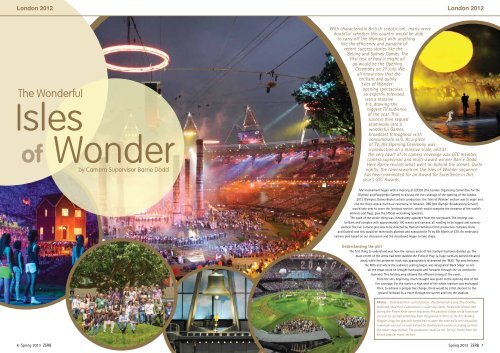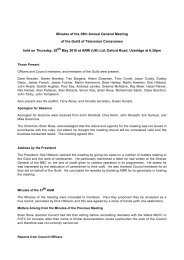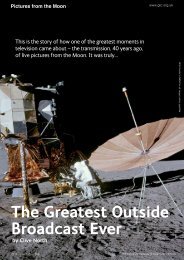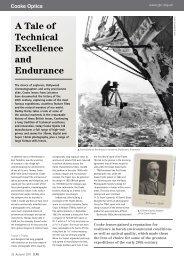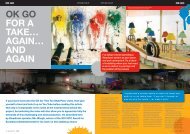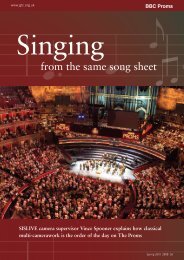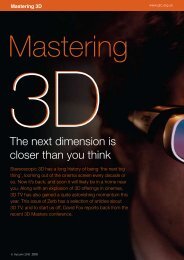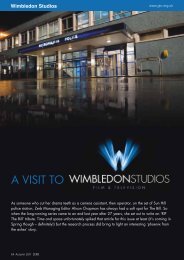The Wonderful - The Guild of Television Cameramen
The Wonderful - The Guild of Television Cameramen
The Wonderful - The Guild of Television Cameramen
Create successful ePaper yourself
Turn your PDF publications into a flip-book with our unique Google optimized e-Paper software.
London 2012<br />
London 2012<br />
<strong>The</strong> <strong>Wonderful</strong><br />
Isles<br />
Wonder<br />
<strong>of</strong><br />
by Camera Supervisor Barrie Dodd<br />
With characteristic British scepticism, many were<br />
doubtful whether this country would be able<br />
to carry <strong>of</strong>f the Olympics with anything<br />
like the efficiency and panache <strong>of</strong><br />
recent success stories like the<br />
Beijing and Sydney Games. <strong>The</strong><br />
first test <strong>of</strong> how it might all<br />
go would be the Opening<br />
Ceremony on 27 July. We<br />
all know now that the<br />
brilliant and quirky<br />
‘Isles <strong>of</strong> Wonder’<br />
opening spectacular,<br />
so expertly televised,<br />
was a massive<br />
hit, drawing the<br />
biggest TV audience<br />
<strong>of</strong> the year. This<br />
success then segued<br />
seamlessly into a<br />
wonderful Games,<br />
broadcast throughout with<br />
consummate skill. As a piece<br />
<strong>of</strong> TV, the Opening Ceremony was<br />
a production on a massive scale, and at<br />
the very heart <strong>of</strong> its camera coverage was GTC member,<br />
camera supervisor and multi-award winner Barrie Dodd.<br />
Here Barrie reveals what went on behind the scenes. Quite<br />
rightly, the camerawork on the Isles <strong>of</strong> Wonder sequence<br />
has been nominated for an Award for Excellence in this<br />
year’s GTC Awards.<br />
My involvement began with a meeting at LOCOG (the London Organising Committee for the<br />
Olympic and Paralympic Games) to discuss the live coverage <strong>of</strong> the opening <strong>of</strong> the London<br />
2012 Olympics. Danny Boyle’s artistic production, the ‘Isles <strong>of</strong> Wonder’ section was to begin and<br />
end the three-and-a-half hour ceremony. In between, OBS (the Olympic Broadcasting Service)<br />
would take over to cover the ‘protocol section’, which would comprise the entrance <strong>of</strong> the world’s<br />
athletes and flags, plus the <strong>of</strong>ficial welcoming speeches.<br />
<strong>The</strong> scale <strong>of</strong> the whole thing was immediately apparent from the storyboard. <strong>The</strong> concept was<br />
brilliant and complex with approximately 100 scenes and cameos, all needing to be logged and cameraplotted.<br />
<strong>The</strong> live cultural plot was to be directed by Hamish Hamilton (from production company Done<br />
and Dusted) and this would be technically planned and executed for TV by Bill Morris <strong>of</strong> CTV. An embryonic<br />
camera plan based on our discussion and the storyboard began to take shape.<br />
Understanding the plot<br />
<strong>The</strong> first thing to understand was how the various areas <strong>of</strong> the stadium had been divided up. <strong>The</strong><br />
main centre <strong>of</strong> the arena had been dubbed the ‘Field <strong>of</strong> Play’ (a huge carefully domed elevated<br />
area), while the perimeter track was appropriately nicknamed the ‘M25’. <strong>The</strong> area between<br />
the M25 and where the audience seating began was designated ‘Back Stage’ as not<br />
all the props could be brought backwards and forwards through the six vomitories<br />
(tunnels). This holding area allowed the efficient timing <strong>of</strong> the event.<br />
From the very beginning, much thought was given to the opening shot <strong>of</strong> the<br />
live coverage. For the starter, a high shot <strong>of</strong> the whole stadium was envisaged.<br />
<strong>The</strong>n, to achieve a perspective change, there would be a fast descent to the<br />
ground followed by a move through the tunnel and into the stadium.<br />
Photos – Clockwise from central picture: Pandemonium scene (the Cineflex<br />
stabilised head from Cammotion is visible top right); Steadicam silhouetted<br />
during the Akram Khan dance sequence; <strong>The</strong> pastoral village set (a Towercam<br />
can just be spotted extending from the ground in front <strong>of</strong> the hill; Bradley<br />
Wiggins rings the specially forged bell to open the evening (a well disguised<br />
Towercam can just be seen behind Sir Bradley and another is poking up from<br />
the music stage below); <strong>The</strong> production team on the Tor hill; Scene from the<br />
British popular music section.<br />
6 Spring 2013 ZERB www.gtc.org.uk www.gtc.org.uk Spring 2013 ZERB 7
London 2012<br />
This would in turn lead into a fast ascent to once again reveal the entire ‘Field <strong>of</strong><br />
Play’, at this point representing ‘England’s green and pleasant land’, which had been<br />
constructed with 7346 square metres <strong>of</strong> imported turf including crops, complete with<br />
live animals, a model <strong>of</strong> Glastonbury Tor, a cottage, a water-wheel, and actors portraying<br />
villagers at work or playing football and cricket.<br />
Various ideas came up. One was to drop down from a helicopter with a Steadicam<br />
and then ground release to allow a transition through the tunnel and into the stadium.<br />
Once there, this could be hooked onto a Strada crane and elevated high above the arena.<br />
This was entirely possible and workable, however it would be very tricky to time in a live<br />
situation and public area.<br />
<strong>The</strong>n we considered and experimented with the clever and very flexible, waterpro<strong>of</strong><br />
Chapman Hydrascope crane. To link from the pre-opening ‘Countdown’ sequence, which<br />
featured a journey along the Thames from its source and through the countryside,<br />
ending at the River Lea tributary close to the stadium, perhaps our live camera could<br />
crane up and out <strong>of</strong> the water, travel into the stadium and then elevate once inside to<br />
reveal the Field <strong>of</strong> Play. Again, timing this would be very tricky.<br />
With these ideas (and their potentially risky timing issues) having been shelved, the<br />
solution eventually decided upon also involved a Steadicam, only in this version the<br />
operator, wearing a harness, would enter the stadium through the tunnel, seated on<br />
the front <strong>of</strong> an ETV (battery-powered buggy). As the camera arrived in the stadium,<br />
the operator would jump <strong>of</strong>f the buggy and both cameraman and Steadicam would be<br />
attached to a vertical cable and lifted from the ground to 30<br />
metres high over a few seconds (passing a foreground<br />
<strong>The</strong> Steadicams and<br />
handheld cameras were<br />
right in on the action<br />
covering the forging <strong>of</strong><br />
the Olympic ring, their<br />
operators decked out in<br />
firepro<strong>of</strong> costumes to<br />
blend in with the cast<br />
cloud on the way) to achieve the iconic opening<br />
shot we had been striving for.<br />
Keeping a secret<br />
<strong>The</strong> main rehearsals for the event were held<br />
on a huge open site at Dagenham in Essex.<br />
Two open arenas had been marked out to<br />
the actual size so that simultaneous sections<br />
could be blocked out. Thousands <strong>of</strong> volunteers<br />
were bused in and out from Dagenham East<br />
station and yet, quite remarkably,<br />
in what can only be described as<br />
an outbreak <strong>of</strong> ‘mass consensual<br />
trust’, the whole thing was kept<br />
completely secret. Perhaps this<br />
was because <strong>of</strong> the enormity<br />
<strong>of</strong> the show itself but I suspect<br />
it was more that no individual<br />
wanted to let down the very<br />
hands-on and daily approachable<br />
Danny Boyle as he put together what<br />
was clearly going to be an amazing<br />
spectacle.<br />
At Dagenham, the camera team worked<br />
meticulously through the various scenes with<br />
Hamish and 1st AD Manique Rathner, to<br />
fine-tune moves and angles and, crucially,<br />
the timings, and a small team <strong>of</strong> 5D and EX3<br />
operators recorded a rough ground camera<br />
plan, which was edited to complement the<br />
storyboard. This later transposed to our live<br />
camera positions on the Field <strong>of</strong> Play, for which<br />
four handheld and four Steadicams had been<br />
allocated.<br />
Not surprisingly, bearing in mind the summer<br />
we had, it rained a lot during these rehearsals<br />
but we were constantly inspired by the hard work,<br />
enthusiasm and dedication <strong>of</strong> the volunteer cast who<br />
were constantly on hand to move acres <strong>of</strong> wet turf<br />
back and forth in order to help us time the transition from<br />
‘green and pleasant land’ to Pandemonium (the Industrial<br />
Revolution). Watching and listening to 1000 drummers time<br />
their moves as one was both moving and uplifting, and seeing 350<br />
hospital beds hit their marks with dancing nurses and doctors during<br />
a rainstorm was just plain surreal!<br />
Higher angles<br />
With the basic camera coverage coming together, it was time to<br />
work on the middle and higher camera positions. As always with<br />
large stadium shows, a mixture <strong>of</strong> intimate storytelling shots<br />
alongside huge-scale and geography-setting angles was required.<br />
We looked into the possibility <strong>of</strong> a four-point Spidercam, but in<br />
the end it proved unrealistic to try and weave this in amongst the<br />
already complicated overhead catenary, so a two-point Spidercam rig<br />
running north to south on the west side <strong>of</strong> the stadium was agreed<br />
upon.<br />
One <strong>of</strong> many surprise moments <strong>of</strong> the ceremony was to be the<br />
arrival <strong>of</strong> the ‘dove bikes’, 75 bikes manned by winged people in an<br />
original take on the tradition <strong>of</strong> releasing doves into the stadium,<br />
introduced at the end <strong>of</strong> the First World War. To cover the entrance<br />
<strong>of</strong> the dove bikes an exact position was found above the north end<br />
<strong>of</strong> the stadium from which a Cineflex stabilised head could operate.<br />
This was for a high symmetrical overhead view <strong>of</strong> the processional<br />
crossover at the north end <strong>of</strong> the stadium, also allowing the flight<br />
<strong>of</strong> the final dove bike to wing its way from the ground to exit the<br />
stadium. <strong>The</strong> Cineflex was attached to the inner cable ring on its<br />
own ‘T’ piece truss and separate motors were rigged to allow it to be<br />
lowered for maintenance and cleaning. During the dove bike sequence<br />
a segway Steadicam was also skillfully steered amongst the bikes.<br />
Meanwhile at the south-east end <strong>of</strong> the stadium, a 30-metre<br />
Photos: A head for heights essential – Steadicam operators John<br />
Clarke and Dominic Jackson were both required to ‘fly’ over the<br />
action on wires, John for the opening sequence and Dominic in<br />
the Dementor sequence; in the back picture, a fearless rigger from<br />
Unusual Rigging is seen releasing the Cammotion Cineflex camera<br />
and control cables so that the camera could be lowered.<br />
OB’s for the World’s<br />
Greatest Events<br />
Contact: Adam Berger: adam@ctvob.co.uk or Bill Morris: bill@ctvob.co.uk / 020 8453 8989 / www.ctvob.co.uk<br />
Photo credits: BAFTA Awards: BAFTA. Ryder Cup: Hugh Routledge / Rex Features. NFL: Terry Harris / Rex Features. BRIT Awards: Brian Rasic / Rex Features. <strong>The</strong> Ashes: Glyn Thomas / Rex Features<br />
8 Spring 2013 ZERB www.gtc.org.uk www.gtc.org.uk Spring 2013 ZERB 9
London 2012 London 2012<br />
vertical Camcat was rigged to cover<br />
wide shots that could include the<br />
huge specially cast brass Olympic<br />
bell (the largest harmonically<br />
tuned bell in the world), which<br />
Bradley Wiggins struck at the<br />
very start <strong>of</strong> the ceremony.<br />
<strong>The</strong> Camcat could also<br />
<strong>of</strong>fer tighter shots <strong>of</strong> action<br />
on the music stage and<br />
dramatic moving shots.<br />
An 85ft Panavision<br />
Strada crane was positioned<br />
at the northeast end <strong>of</strong> the<br />
M25 perimeter track, its main<br />
job being to show the scale and<br />
geography <strong>of</strong> the Field <strong>of</strong> Play.<br />
<strong>The</strong> Olympic ring is lifted<br />
Of course, quite a few complex rigging issues arose<br />
during the quest to do justice to the elaborate story that had<br />
been dreamt up by Danny Boyle and writer Frank Cottrell Boyce,<br />
not least <strong>of</strong> which involved the coverage <strong>of</strong> the highly symbolic moment when the newly<br />
smelted central Olympic ring would be lifted up to join the four other rings already<br />
suspended on wires and moving to their final position high up in the stadium.<br />
For this important sequence, a Towercam would be positioned underneath the Field <strong>of</strong><br />
Play; it was only really possible to work out the logistics <strong>of</strong> this after seeing and plotting<br />
the rehearsals in situ. This Towercam, with its remote head having been fully fire- and<br />
waterpro<strong>of</strong>ed ready for the coverage <strong>of</strong> the incandescent Olympic ring, spent most<br />
<strong>of</strong> the time buried 12 feet under the thatched cottage, sheep, geese and turf <strong>of</strong> the<br />
‘green and pleasant land’. Once all this had been<br />
cleared away to make way for the Industrial<br />
Revolution (Pandemonium sequence),<br />
a trapdoor opened to allow the<br />
Towercam to pop out and deliver its<br />
unique shot looking up at the five<br />
Olympic Rings as they came<br />
together, before retracting to<br />
allow the trapdoor to close<br />
again so that the 500 or so<br />
dancers could perform safely<br />
for the remaining sequences.<br />
<strong>The</strong> point loading <strong>of</strong> the<br />
amazing structure, the Field<br />
<strong>of</strong> Play, on which this whole<br />
sequence was based (remember<br />
it had carthorses on it as well)<br />
was about 3 to 4 tons. Underneath<br />
(as well as the two Towercams) it<br />
hid seven mighty 80-foot chimneys plus<br />
dozens <strong>of</strong> props and machinery worthy <strong>of</strong> H.G.<br />
Wells, not to mention hundreds <strong>of</strong> miners who would<br />
ascend through the Tor once the symbolic oak tree had<br />
been uprooted. So it was with some trepidation that I<br />
approached the expert who had built it to ask if he would<br />
mind cutting a few holes in it and then re-enforcing them<br />
with trapdoors! By a fortunate coincidence (once we had<br />
recognised each other through our safety hard hats, goggles,<br />
etc) we realised that we had worked together 12 years<br />
previously (on a job when I had also asked him to cut a few<br />
holes in his set!) So, no problem.<br />
Meanwhile, the Steadicams and handheld cameras had<br />
been right in on the action covering the forging <strong>of</strong> the ring, their<br />
operators decked out in firepro<strong>of</strong> costumes to blend in with the cast.<br />
Twelve sets <strong>of</strong> this protective gear (comprising boiler suits and snoods<br />
for the head) were needed for the operators, assistants and focus-pullers.<br />
Prior to the event some quite extensive testing <strong>of</strong> the gear to see what it<br />
would be like to operate in had already taken place, and once again<br />
the timing <strong>of</strong> stripping <strong>of</strong>f this cumbersome gear to be ready for<br />
operating on the rest <strong>of</strong> the sequences all had to be worked out and<br />
rehearsed.<br />
For the moment when the newly forged centre ring joined the<br />
others, a specially conceived one-<strong>of</strong>f ‘super dolly trolly-cam’ was<br />
added into the web <strong>of</strong> flying cables. This was a remote R/F camera<br />
with pan and tilt head which trollied out to give an overhead<br />
symmetrical shot just <strong>of</strong> this moment.<br />
More towers, jibs and dollies<br />
A second Towercam hidden underground popped up for Kenneth<br />
Branagh’s ‘Brunel speech’ at the north Tor end. In addition, two other<br />
Towercams were in use at the south end, one behind the Olympic<br />
bell and the other at stage level to cover music. Also in area <strong>of</strong> the<br />
bell was a 22-foot jib on track and this could <strong>of</strong>fer stunning south<br />
to north shots. A further jib was situated at ground level, once again<br />
to cover solo artists on the music stage and a huge variety <strong>of</strong> other<br />
shots in this area.<br />
To obtain close-ups on the music stage we had an 86x lens<br />
mounted on an (appropriately named) Olympian (Chapman) tracking<br />
dolly. This manoeuvrable vehicle<br />
allowed us to reposition back and<br />
forth around the M25 with a variable<br />
lens height up to 19 feet high. <strong>The</strong><br />
other four 86x lenses were positioned<br />
around the middle balcony <strong>of</strong> the stadium,<br />
to give height and the ability to look into the<br />
constant action and activity going on all around the<br />
Field <strong>of</strong> Play.<br />
Other high points <strong>of</strong> the proceedings were the Mary<br />
Poppins and Harry Potter Dementor sequences, when<br />
the Steadicam operator once again took to the air<br />
to integrate with the aerial action with a flying<br />
Steadicam.<br />
To complete the camera line-up, on two <strong>of</strong> the<br />
twelve outer stadium structural masts we<br />
positioned SMAR<strong>The</strong>ads, one on the east<br />
side and the other on the west. <strong>The</strong>se were<br />
again to look down on the complex dance<br />
sequences and patterns.<br />
Above all <strong>of</strong> this the obligatory helicopter<br />
and blimp were hovering to give an array <strong>of</strong><br />
fantastic live precision shots to fully reflect the<br />
scale <strong>of</strong> the event.<br />
When I was asked to write this article I<br />
immediately thought <strong>of</strong> the vast number <strong>of</strong><br />
truly amazing people who had been involved<br />
and who all contributed in their different ways<br />
to making the Opening such a success. Just think:<br />
production, lighting, flying, rigging, sound, vision,<br />
choreographers, volunteer cast, each section bringing<br />
to it their own story <strong>of</strong> complexity. So, this personal<br />
recollection for Zerb is about the multi-camera coverage<br />
part <strong>of</strong> the whole, <strong>of</strong> which it was a great honour to be a<br />
part. If truth be told, the whole event was made possible by an<br />
incredible team with wonderful expertise working together under<br />
great leadership. That seems to be a winning recipe!<br />
Camera Kit<br />
• 4x handheld cameras (3x RF and 1x cabled)<br />
• 5x 86:1 lens cameras<br />
• 5x Steadicams (2x with flying harnesses and 1x Segway)<br />
• 4x Towercams (Alan Wells)<br />
• 1x Strada crane (Panavision)<br />
• 1x Spidercam<br />
• 1x Camcat<br />
• 2x Jimmy jibs<br />
• 1x Cineflex (Cammotion)<br />
• 2x SMAR<strong>The</strong>ads (ACS)<br />
• 1x Chapman Olympian dolly<br />
• 1x Chapman ETV tracking vehicle<br />
• 1x Super Trolly RF<br />
• 1x helicopter<br />
• 1x blimp<br />
Photos clockwise from top left: Olympic bell<br />
as night fell – the 22ft jib on tracks can be seen<br />
silhouetted; As the winged doves rode on bikes<br />
around the stadium Steadicam operator Curtis<br />
Dunne was skilfully moving through them on a<br />
Segway; When the fifth Olympic ring was forged,<br />
camera operators and assistants were dressed in<br />
costume and firepro<strong>of</strong> gear so that they could<br />
merge in with the cast (camera assistant Nicki<br />
Graves is seen here in the ‘snood’ outfit).<br />
10 Spring 2013 ZERB www.gtc.org.uk www.gtc.org.uk Spring 2013 ZERB 11
London 2012<br />
Isles <strong>of</strong> Wonder Camera Crew<br />
Camera Operators<br />
• Barrie Dodd – Cineflex gyro head/<br />
SMAR<strong>The</strong>ad<br />
• John Dibley – 86:1 lens camera<br />
• Nick Kauffman – 86:1 lens camera<br />
• Harriet Sheard – 86:1 lens camera<br />
• Rob Sargent – 86:1 lens camera<br />
• Chris Chatfield – 86:1 lens camera<br />
• Curtis Dunne – Steadicam (plus Segway)<br />
• Martyn Porter – Steadicam<br />
• Jim Littlehayes – Steadicam<br />
• Dominic Jackson – Steadicam (plus flying rig)<br />
• John Clarke – Steadicam (plus flying rig)<br />
• Rob Mansfield – RF handheld<br />
• Martin Schlote – RF handheld<br />
• Prav Shetty – RF handheld<br />
• Nat Hill – Handheld<br />
• Marcus Petersell – Camcat<br />
• Andy Watt – SMAR<strong>The</strong>ad<br />
• Kevin French – Strada crane<br />
• Dave Emery – Jimmy jib<br />
• Tim Normington – Jimmy jib<br />
• Frank Stutzke- Spidercam<br />
• Ben Frewin – Towercams 1 and 2<br />
• Alan Wells – Towercam 3<br />
• Shaun Willis – Towercam 4<br />
• Derek Pennell – Chapman Olympian dolly<br />
• Peter Johnson – Super Trolly RF camera<br />
• John Marzano – Helicoptor operator<br />
5D, GoPro, EX3 Operators<br />
• Joseph Myerscough<br />
• Aaron O’Sullivan<br />
• Nick Rose<br />
• James Williams<br />
Focus-Pullers<br />
• Warren Buckingham<br />
• James Knight<br />
• Rebecca McDonald<br />
• Svetlana Miko<br />
• Joe Oliver<br />
• Chris Robertson<br />
Camera Assistants<br />
• Nicki Graves<br />
• Guiseppi Ingrao<br />
• Carl Veckranges<br />
• John Wright<br />
• Louise Elliot<br />
CTV Camera Guarantees<br />
• Sam Bogeart<br />
• Tim Deacan<br />
Cable Bashers<br />
• Matt Ford<br />
• Sarah Morris<br />
• Laura Romback<br />
Towercam Assistants<br />
• Dan Besley<br />
• Peter Childs<br />
• Matt Cowley<br />
• James Woods<br />
Jimmy Jib Assistants<br />
• Louis Blair<br />
• Dave Coomber<br />
• Giles Mallard<br />
Grips<br />
• Ken Ashley Johnson (Strada)<br />
• Colin Brown (Strada)<br />
• Stacey Hancock (Strada)<br />
• Clive Tocher (Strada)<br />
• Paul Birchard<br />
Camera Technician<br />
• Mike Wright (Cammotion Cineflex)<br />
Vision Mixer<br />
• Rod Wardell<br />
Vision Supervisor<br />
• Luke Chantrel<br />
Floor Managers<br />
• Michael Matheson<br />
• Roger Dempster<br />
Photos – Above: Team effort – the whole camera<br />
crew does the “Lightning Bolt” in front <strong>of</strong> the<br />
Olympic Stadium (look carefully and you’ll realise<br />
they’re doing it with the wrong arm – typical<br />
cameramen who can’t tell left from right!);<br />
Top right: Director Hamish Hamilton celebrates the<br />
successful broadcast; Right: Barrie with a wellearned<br />
chocolate gold medal!<br />
Fact File<br />
Barrie Dodd is a founder GTC member. He is freelance with<br />
many years’ facility experience in all areas <strong>of</strong> live and<br />
multicamera coverage.<br />
With thanks to LOCOG, Mark Bushkes <strong>of</strong> Magic Bean Studio<br />
and various crew members for the photographs.<br />
12 Spring 2013 ZERB www.gtc.org.uk


